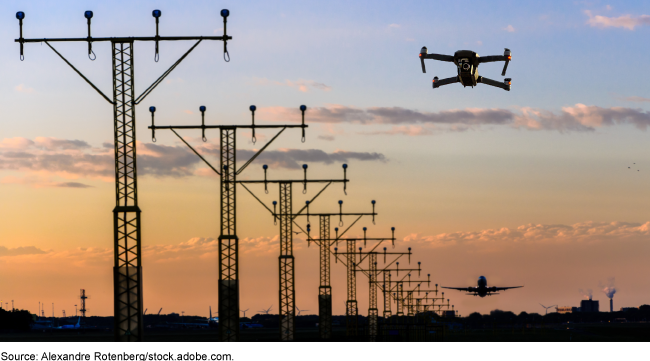FAA Workforce: Better Assessing Employees' Skill Gaps Could Help FAA Prepare for Changes in Technology
Fast Facts
The Federal Aviation Administration relies on a workforce of nearly 45,000 to operate the national airspace system. Changes in the aviation industry—including emerging technologies such as drones—will require FAA to increase oversight and seek additional critical skills for its workforce.
FAA has identified critical skills needed for its workforce to respond to technology changes. However, FAA's assessment of the skills of its current workforce was insufficient to show how many employees have needed skills and where the skills gaps are. We recommended a more thorough workforce skill gap assessment.

Highlights
What GAO Found
Through its workforce-planning initiative, the Federal Aviation Administration (FAA) identified critical skills needed for its workforce to respond to technology changes, such as those described in the figure below. The FAA's efforts are consistent with leading principles of effective workforce planning. These principles call for agencies to determine the critical skills needed to achieve current and future programmatic results. For example:
- In 2018, FAA's Office of Human Resource Management began an agency-wide Strategic Workforce Planning Initiative to assess the skills FAA's workforce needs today and will increasingly need in the future. These skills include data analytics, project management, and cybersecurity skills.
- Individual FAA offices also conduct workforce-planning activities. Selected offices have taken steps to identify critical future skills, such as specific technical skills for the engineers in the Office of Commercial Space Transportation.
Examples of Technology Changes Expected to Affect FAA's Workforce

FAA also has taken steps to determine whether its workforce has the skills needed to respond to technology changes, but these efforts have not been quantitative nor have they included all mission-critical occupations. In 2019, FAA conducted interviews with managers and staff to collect officials' perspectives on what skill gaps exist. While the qualitative interviews yielded useful information on the skills needed, they did not provide measurable data showing how many employees have the skills needed and where gaps exist. FAA also obtained some information on skill gaps in its workforce from a 2020 Department of Transportation workforce assessment, but FAA's response rate to that assessment was low, ranging from 12 to 25 percent. As a result, the information FAA has collected may not provide a complete assessment of whether its workforce has the critical skills needed to respond to technology changes. Recognizing these limitations, FAA officials said they intend to conduct additional skill gap assessments. However, officials said that because FAA is a large and dynamic agency, the process of completing agency-wide skill gap assessments will require better coordination with individual FAA offices. Thus, FAA has shifted its focus to developing a strategic workforce- planning policy and community of practice to facilitate agency-wide coordination on workforce-planning activities. These efforts represent positive steps and could help FAA conduct more comprehensive skill gap assessments in the future.
Why GAO Did This Study
FAA relies on a skilled and specialized workforce of nearly 45,000 employees to operate and oversee the national airspace system. However, changes in the aviation industry—including emerging technologies and non-traditional users, such as unmanned aircraft systems (i.e., drones)—will require FAA to increase oversight activities and seek additional critical skills for its workforce.
The FAA Reauthorization Act of 2018 included a provision for GAO to assess FAA's workforce-planning efforts, among other things. This report examines the extent to which FAA has: (1) identified the critical skills its current and future workforce will need as a result of changes in aviation technology and (2) determined whether its current workforce has those skills.
GAO analyzed FAA workforce-planning documentation, including documents describing its Strategic Workforce Planning Initiative. GAO interviewed officials from five selected FAA offices whose work will likely be affected by changing technologies. To obtain a range of perspectives, GAO interviewed representatives from industry associations and FAA labor groups, such as the National Air Traffic Controllers Association.
Recommendations
GAO is recommending that FAA should ensure that planned skill gap assessments, conducted in coordination with FAA offices, are quantitative and include all mission-critical occupations. FAA concurred with our recommendation.
Recommendations for Executive Action
| Agency Affected | Recommendation | Status |
|---|---|---|
| FAA Human Resources Management | The Assistant Administrator for Human Resource Management should ensure that planned skill gap assessments, conducted in coordination with FAA offices, are based on quantitative information about gaps in all critical skills for employees across all mission-critical occupations. |
In July 2024, GAO contacted FAA to determine if the agency had made any progress in implementing this recommendation. GAO is awaiting FAA's response and will update the status of this recommendation accordingly.
|
